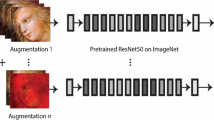Abstract
This paper presents the application of Deep-Dream algorithm for data augmentation applied to images. This algorithm analyzes the image by a trained neural network and hides main features of the image. Importance and place of the features is estimated based on neural network layers output values. The new neural network trained on the processed data are forced to search and train a new set of features in the data, since the known features have been hidden. Trained on original and processed data neural networks are used in an ensemble. Experiments were conducted with a balanced images dataset with 5000 images in 10 classes. Experiment was conducted with a neural network based on InceptionV3 architecture in two variations: with non pretrained weights and with pretrained weights. The neural network received a 256 × 256 pixel image as input. Training was conducted using categorical cross entropy loss function, accuracy metric, Adam optimizer with a learning rate of 0.0001. The improvements of the algorithm are almost insignificant when classifying an ensemble of neural network models for a small number of classes, but the impact of the algorithm increases as the number of classes increases. For binary classification there may be no improvement in ensemble accuracy, but when the number of classes increases and becomes more than 5, the influence of the algorithm on the accuracy of the final ensemble increases. The improvement in ensemble accuracy can be 0.5–4%, depending on the initial training conditions without the use of other types of data processing and augmentation.
Access this chapter
Tax calculation will be finalised at checkout
Purchases are for personal use only
Similar content being viewed by others
References
Luis, P., Jason, W.: The effectiveness of data augmentation in image classification using deep learning
Shorten, C., Khoshgoftaar, T.M.: A survey on image data augmentation for deep learning. J. Big Data 6(1), 1–48 (2019). https://doi.org/10.1186/s40537-019-0197-0
Ilya, K., Denis, Y., Rob, F.: Image augmentation is all you need: regularizing deep reinforcement learning from pixels. arXiv preprint arXiv:2004.13649
Han, D., Liu, Q., Fan, W.: A new image classification method using CNN transfer learning and web data augmentation. Expert Syst. Appl. 95, 43–56 (2018)
Shin, H.-C., et al.: Medical image synthesis for data augmentation and anonymization using generative adversarial networks. In: Gooya, A., Goksel, O., Oguz, I., Burgos, N. (eds.) SASHIMI 2018. LNCS, vol. 11037, pp. 1–11. Springer, Cham (2018). https://doi.org/10.1007/978-3-030-00536-8_1
Koitka, S., Friedrich, C.M.: Optimized convolutional neural network ensembles for medical subfigure classification. In: Jones, G.J.F., et al. (eds.) CLEF 2017. LNCS, vol. 10456, pp. 57–68. Springer, Cham (2017). https://doi.org/10.1007/978-3-319-65813-1_5
Li, H., Wang, X., Ding, S.: Research and development of neural network ensembles: a survey. Artif. Intell. Rev. 49(4), 455–479 (2017). https://doi.org/10.1007/s10462-016-9535-1
William, B., Tim, G., Andreas, N., Jan, K.: The power of ensembles for active learning in image classification. In: Proceedings of the IEEE Conference on Computer Vision and Pattern Recognition (CVPR), pp. 9368–9377 (2018)
Mordvintsev, A., Olah, C., Tyka, M.: DeepDream - a code example for visualizing Neural Networks. Google Research (2015)
Alessio, C.: Animals-10 dataset. Kaggle (2019). https://www.kaggle.com/alessiocorrado99/animals10
Christian S., Vincent V., Sergey I., Jonathon S., Wojna Z.: Rethinking the inception architecture for computer vision. arXiv preprint arXiv:1512.00567v3
Gregory, C.: Deep dream. SubStance 45(2), 61–77 (2016)
Alam, K.M.R., Siddique, N., Adeli, H.: A dynamic ensemble learning algorithm for neural networks. Neural Comput. Appl. 32(12), 8675–8690 (2019). https://doi.org/10.1007/s00521-019-04359-7
Author information
Authors and Affiliations
Corresponding author
Editor information
Editors and Affiliations
Rights and permissions
Copyright information
© 2022 The Author(s), under exclusive license to Springer Nature Singapore Pte Ltd.
About this paper
Cite this paper
Viaktin, D., Garcia-Zapirain, B., Mendez Zorrilla, A. (2022). DeepDream Algorithm for Data Augmentation in a Neural Network Ensemble Applied to Multiclass Image Classification. In: Szczerbicki, E., Wojtkiewicz, K., Nguyen, S.V., Pietranik, M., Krótkiewicz, M. (eds) Recent Challenges in Intelligent Information and Database Systems. ACIIDS 2022. Communications in Computer and Information Science, vol 1716. Springer, Singapore. https://doi.org/10.1007/978-981-19-8234-7_51
Download citation
DOI: https://doi.org/10.1007/978-981-19-8234-7_51
Published:
Publisher Name: Springer, Singapore
Print ISBN: 978-981-19-8233-0
Online ISBN: 978-981-19-8234-7
eBook Packages: Computer ScienceComputer Science (R0)




